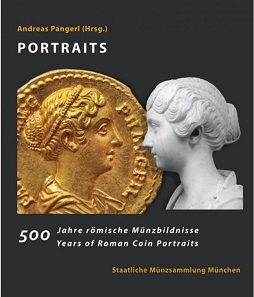by Ursula Kampmann
translated by Christina Schlögl
April 20, 2017 – “The coins in this catalogue of portraits were all taken from private collections and trade, except for the numbers…” That it how Andreas Pangerl, initiator and editor of this precious new coffee table book with magnificent images of Roman coins, summarises the origin of the pieces depicted in the book. He is a passionate collector of Roman coins himself and does not only collect the objects themselves but also photographs of them. Almost all coin depictions – with only a few exceptions – were photographed by Pangerl himself using natural light. He took these images with so much love and commitment that, in terms of portraits, this book might well be the successor of the legendary Hirmer.
Andreas Pangerl (Ed.), Portraits. 500 Years of Roman Coin Portraits / 500 Jahre römische Münzbildnisse. Staatliche Münzsammlung München, Munich 2017. 452 p., all images in colour. Hardcover. 29.5 x 25.3 cm. ISBN: 978-3-922840-36-7. 59 Euro plus shipping.
As the title “Portraits – 500 Years of Roman Coin Portraits / 500 Jahre römische Münzbildnisse” already suggests, this heavyweight publication is aimed at the international market, which makes sense, considering that the images are the main focus of the book. Readers will find 722 portraits on 233 pages, including a complete series of the Roman rulers in essence from Caesar – there are some emperors included – until Julius Nepos. There are also spouses, sisters, mothers and Caesars. The objects were selected according to their beauty, considering condition, centring, die cutting and minting. Consequently flicking through the book will be a delight to everyone who enjoys coins. A short caption consisting of emperor, years of reign, denomination, minting date and location as well as RIC-quote is attached every image. There are no precise descriptions, nor does the book feature images of the reverses. However there is a selection of particularly beautiful and interesting reverses on pages 248 to 268.
The second part of the book unites different articles on several topics of Roman portrait art. The time spectrum starts at Caesar and ends with Theodosius. The authors, all of which have written their contributions in German – except for Olivier Hekster, who has written his “Severus – Antonine Emperor or the first Severan?” in English, consist of renowned historians like Werner Eck and Kay Ehling, coin dealers like Hans-Christoph von Mosch and Wilhelm Müseler, as well as numerous archaeologists like Christian Gliwitzky, Marion Meyer, Jörn Lang and Melanie Lang, and Markus Löx. The initiator of the book, although he is a doctor by trade, has contributed three articles himself. The articles thus cover the entire Roman imperial period.
This book is not just a representation of what is probably the most wide-spread field of collection around the world. After all Roman coins are not only collected in Europe, but also in the US, South America, Japan or Thailand. This publication is rather a symbol for the close connection between museums, collectors, scholars and coin dealers. The Staatliche Münzsammlung München has accepted this splendid publication into their publication series. Collectors and traders have offered their objects and photographs just like the Bibliothèque nationale, the Ashmolean Museum and the Staatliche Münzsammlung München have. A collector has taken the photos and initiated the book. A numismatist, Hertha Schwarz, was responsible for the clear and vivid layout. Matthias Barth of the Staatliche Münzsammlung München did editorial work. Scholars, coin dealers and collectors collaborated to create the articles for the second part. It is thus safe to say that this book demonstrates how all branches of numismatics can (and must) work together to implement something good.
There is only one thing left to wish for, I think, one desideratum. Seeing as most of the coins came from collections and auctions, I would have particularly wanted to know from which auction or from which collection they were taken (private collection and city would have sufficed). After all, every auctioneer would be honoured to have a coin that can be depicted in such a precious book. If museums got the privilege of having their coins named individually, then this should have also been done for auction houses and collectors.
Nonetheless “Portraits” remains a treat for the eyes – a treat you can buy for 59 Euros (plus postage and packing) at the Münzsammlung München.
If you would like to order the book (or any other book from the extensive stock of publications from Munich) please send an email. You can download the catalogue of all publications here.




